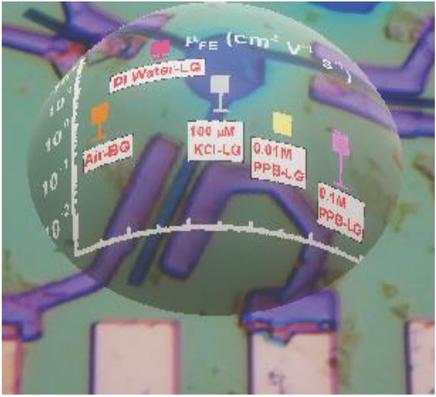当前位置:
X-MOL 学术
›
Adv. Electron. Mater.
›
论文详情
Our official English website, www.x-mol.net, welcomes your
feedback! (Note: you will need to create a separate account there.)
Probing Electron Mobility of Monolayer MoS2 Field‐Effect Transistors in Aqueous Environments
Advanced Electronic Materials ( IF 5.3 ) Pub Date : 2018-02-12 , DOI: 10.1002/aelm.201700418 Ming-Pei Lu,Xiao-Yen Dai,Ming-Yen Lu
Advanced Electronic Materials ( IF 5.3 ) Pub Date : 2018-02-12 , DOI: 10.1002/aelm.201700418 Ming-Pei Lu,Xiao-Yen Dai,Ming-Yen Lu

|
Atomically thin layered 2D semiconductors have inspired intense interest in building hybrid liquid–semiconductor electronic systems for next‐generation biological/chemical sensing applications. There remains, however, a lack of understanding of the electrical characteristics of 2D materials in aqueous environments and, thereby, much useful information for advancing the development of such emerging sensor systems. In this study, the effects of aqueous environments on the field‐effect electron mobility (µFE) of monolayer molybdenum disulfide (MoS2) field‐effect transistors (FETs), using various operational modes (back‐gating, liquid‐gating, and dual‐gating), are explored at room temperature. The value of µFE of the MoS2 exposed to deionized (DI) water is much greater than that treated merely under ambient conditions, presumably the result of a dielectric screening effect. When the DI water is changed to a biologically compatible buffer (0.01 or 0.1 m potassium phosphate buffer) at pH 7, the value of µFE decreases significantly. Further investigation into the possible origin of the degraded mobility suggests that the ions in the aqueous solutions play an important role as additional scatterers. This report should enhance the understanding of the mechanisms of mobility scattering in liquid–semiconductor 2D FET systems for applications in hybrid electronics, bioelectronics, and nanosensors.
中文翻译:

在水环境中探测单层MoS2场效应晶体管的电子迁移率
原子薄层2D半导体引起了人们对于构建用于下一代生物/化学传感应用的混合液-半导体电子系统的浓厚兴趣。然而,仍然缺乏对在水环境中的2D材料的电特性的理解,并因此缺乏用于推进这种新兴传感器系统的开发的有用信息。在本研究中,使用各种操作模式(背浇注,液体浇注和重载)对水性环境对单层二硫化钼(MoS 2)场效应晶体管(FET)的场效应电子迁移率(µ FE)的影响双重浇口),在室温下进行探索。MoS 2的µ FE值暴露于去离子(DI)水中的水比仅在环境条件下处理的水要大得多,这大概是介电屏蔽效应的结果。当DI水被改变为生物相容的缓冲液(0.01或0.1米在pH7磷酸钾缓冲液),的值μ FE显著降低。对降低的迁移率的可能原因的进一步研究表明,水溶液中的离子作为额外的散射体起着重要的作用。该报告应增进对混合电子,生物电子和纳米传感器中应用的液半导体2D FET系统中迁移率散射机制的了解。
更新日期:2018-02-12
中文翻译:

在水环境中探测单层MoS2场效应晶体管的电子迁移率
原子薄层2D半导体引起了人们对于构建用于下一代生物/化学传感应用的混合液-半导体电子系统的浓厚兴趣。然而,仍然缺乏对在水环境中的2D材料的电特性的理解,并因此缺乏用于推进这种新兴传感器系统的开发的有用信息。在本研究中,使用各种操作模式(背浇注,液体浇注和重载)对水性环境对单层二硫化钼(MoS 2)场效应晶体管(FET)的场效应电子迁移率(µ FE)的影响双重浇口),在室温下进行探索。MoS 2的µ FE值暴露于去离子(DI)水中的水比仅在环境条件下处理的水要大得多,这大概是介电屏蔽效应的结果。当DI水被改变为生物相容的缓冲液(0.01或0.1米在pH7磷酸钾缓冲液),的值μ FE显著降低。对降低的迁移率的可能原因的进一步研究表明,水溶液中的离子作为额外的散射体起着重要的作用。该报告应增进对混合电子,生物电子和纳米传感器中应用的液半导体2D FET系统中迁移率散射机制的了解。











































 京公网安备 11010802027423号
京公网安备 11010802027423号